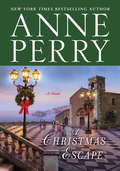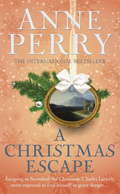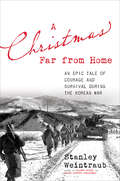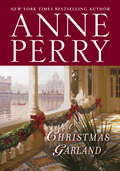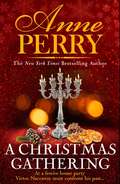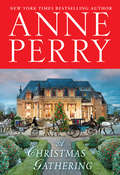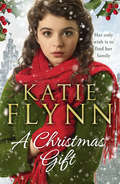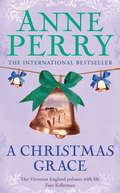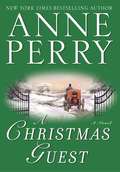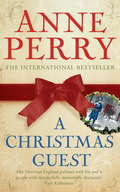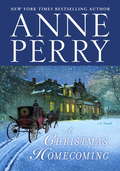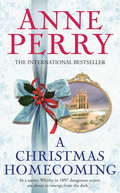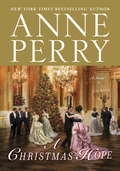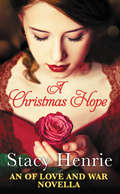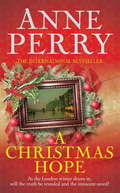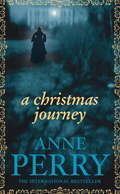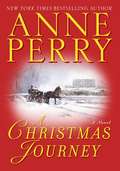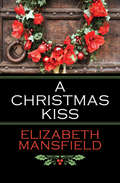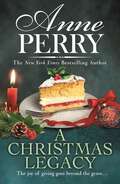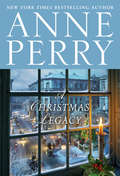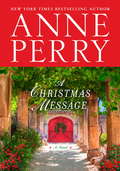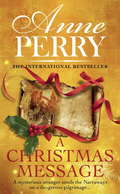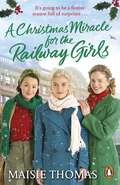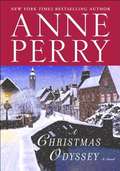- Table View
- List View
A Christmas Escape
by Anne PerryFor countless readers, Christmastime means a delicious new holiday mystery from New York Times bestselling author Anne Perry. A Christmas Escape, her thirteenth noel to the season, transports us to the Mediterranean island of Stromboli for an unconventional Yuletide adventure--and an unforgettable volcanic encounter. Lonely Charles Latterly arrives at his small hotel hoping that the island's blue skies and gentle breezes will brighten his spirits. Unfortunately, there's no holiday cheer to be found among his fellow guests, who include a pompous novelist, a stuffy colonel, a dangerously ill-matched married couple, and an ailing old man. The one charming exception is orphaned teenager Candace Finbar, who takes Charles under her wing and introduces him to the island's beauty. But the tranquility of the holiday is swiftly disrupted by a violent quarrel, an unpleasant gentleman's shocking claims of being stalked, and the ominous stirrings of the local volcano. Then events take an even darker turn: A body is found, and Charles quickly realizes that the killer must be among the group of guests. Captivating in its depiction of untamed nature in all its awesome power, and of the human heart in the throes of transformation, A Christmas Escape gifts readers with Anne Perry's talent for making the season brighter--and more thrilling. Praise for the Christmas novels of Anne Perry "Perry's Victorian-era holiday mysteries [are] an annual treat."--The Wall Street Journal A New York Christmas "A thoroughly enjoyable mystery set against the wonderful historical backdrop of 1904 New York City at Christmastime."--Library Journal (starred review) A Christmas Hope "Very much recommended . . . a wonderful story."--Historical Novel Review A Christmas Garland "In Anne Perry's gifted hands, the puzzle plays out brilliantly."--Greensboro News & Record A Christmas Homecoming "Could have been devised by Agatha Christie . . . [Perry is] a modern master."--Pittsburgh Post-Gazette A Christmas Odyssey "[Perry] writes with detail that invades the senses."--Lincoln Journal StarFrom the Hardcover edition.
A Christmas Escape: A festive murder mystery set on a lonely Italian island (Christmas Novella #13)
by Anne PerryEscaping to Stromboli for Christmas, Charles Latterly never expected to find himself in grave danger... Set in Italy in 1866, A Christmas Escape is Anne Perry's thirteenth festive Victorian novella. Perfect for fans of C. J. Sansom and Harriet Smart.December, 1866. Charles Latterly, Hester Monk's brother, travels to Italy to spend Christmas on the volcanic island of Stromboli. In his secluded mountain hotel a curious group of people have gathered, and Charles senses a brittle strain between some of his fellow guests as they visit the crater of the island's famous rumbling volcano.While the guests prepare for Christmas, the volcano threatens to erupt, and they realise they must leave at once. As they plan their escape, with Charles thrust reluctantly into leading the group to shelter, one of their number is found dead. But if this is murder, there is a killer in their midst, and Charles must navigate a path to safety... What readers are saying about A Christmas Escape: 'An interesting and exciting read... the characters were well drawn and the story was tense and well plotted''A well written novella with a furiously fast ending, much enjoyed''Perry creates such wonderful descriptions... that places come to life under her deft hand'
A Christmas Far from Home: An Epic Tale of Courage and Survival during the Korean War
by Stanley WeintraubAn anecdote-rich narrative of the 1950 holiday season during the Korean War, when, just after Thanksgiving, tens of thousands of US troops were surrounded in the Chosin reservoir area by hundreds of thousands of Chinese troops and began a terrible and difficult retreat, which finally ended on Christmas Day.
A Christmas Garland
by Anne Perry"An annual treat," declared The Wall Street Journal of Anne Perry's Victorian-era holiday mysteries. Now she continues this magnificent tradition with A Christmas Garland, a yuletide tale set in exotic India. This time the mistress of mystery tells the story of a terrible crime that sets the stage for another: accusing an innocent man of murder. The year is 1857, soon after the violent Siege of Cawnpore, with India in the midst of rebellion. In the British garrison, a guard is killed and an Indian prisoner escapes, which leads to yet more British deaths. Cries for revenge are overwhelming. Despite no witnesses and no evidence against him, a luckless British medical orderly named John Tallis is arrested as an accomplice simply because he was the only soldier unaccounted for when these baffling crimes were committed. Though chosen to defend Tallis, young Lieutenant Victor Narraway is not encouraged to try very hard. Narraway's superiors merely want a show trial. But inspired by a soldier's widow and her children, and by his own stubborn faith in justice, Narraway searches for the truth. In an alien world haunted by memories of massacre, he is the accused man's only hope. The trial of John Tallis equals the white-knuckle best of Anne Perry's breathtaking courtroom dramas. And thanks to a simple Christmas garland and some brilliant detective work, Narraway perseveres against appalling odds, learning how to find hope within himself--and turn the darkest hour into one full of joy and light. PRAISE FOR THE CHRISTMAS NOVELS OF ANNE PERRY A Christmas Homecoming "Could have been devised by Agatha Christie . . . [Perry is] a modern master."--Pittsburgh Post-Gazette "Vastly entertaining . . . uplifting and thought-provoking by turns."--The Star-Ledger A Christmas Odyssey "[Perry] writes with detail that invades the senses."--Lincoln Journal Star A Christmas Promise "Poignant . . . should be on the Christmas stocking list of anyone who likes a sniffle of nostalgia."--The Washington Times A Christmas Grace "[A] heartwarming, if crime-tinged, complement to the holiday season."--Booklist A Christmas Beginning "Intriguing . . . Perry's use of period detail is, as always, strong and evocative."--The Seattle TimesFrom the Hardcover edition.
A Christmas Garland: A festive mystery set in nineteenth-century India (Christmas Novella #10)
by Anne PerryAs Christmas approaches, justice must be served... Anne Perry sweeps her readers away to India in her tenth seasonal novella, A Christmas Garland. Perfect for fans of C. J. Sansom and Sherlock Holmes.'Perry avoids all of the mawkish pitfalls that are usually the hallmark of holiday books by choosing an unconventional setting and decidedly different approach. Rather than leaning on sentiment, she writes an honest, though somewhat grim, story that captures the essence of 19th-century India and the character of a compassionate man. A novel approach to an oft-explored subject, this tale will delight Perry's fans and bring her new ones' - Kirkus Reviews1857. After the fire of mutiny has swept through British India, young Lieutenant Victor Narraway arrives at a battered military base at Cawnpore. It is just two weeks before Christmas, but no one is able to celebrate: they have been betrayed. A soldier under arrest for dereliction of duty has killed a guard and escaped to join the rebels, taking crucial information that led to the massacre of nine men on patrol. Someone must have helped him, and medical orderly John Tallis is the only man unaccounted for at the time. He is now on trial for his life, and Narraway is commanded to defend him.Narraway knows that his is an impossible task. The British Army needs justice to be carried out in full, and there seems no doubt of Tallis's guilt. But Narraway cannot see any motive for his actions. Will an innocent man hang before Christmas? What readers are saying about A Christmas Garland: 'Make yourself a pot of tea, turn on your reading lamp and settle in for another deliciously atmospheric tale from Perry''Christmas would not be Christmas without a Perry novella''Five stars'
A Christmas Gathering (Christmas Novella 17)
by Anne PerryA festive house party takes a sinister turn...Victor Narraway and his wife, Lady Vespasia, are invited to spend Christmas at Cavendish Hall with a gathering of old acquaintances, but it is not the quiet, rather stiff house party they had expected. While there, Victor must undertake his final mission for Special Branch, reminiscent of another one in the past, at which he had tragically failed.When disaster strikes and one of the guests is left for dead, Victor fears that history is repeating itself. But which of them is intent on murder? And can Victor accept that he is not to blame...?A Christmas Gathering is the gripping new festive mystery from the pen of Anne Perry, the master of Victorian crime.
A Christmas Gathering: A Novel
by Anne PerryA cold case adds an extra chill to the holiday season as bestselling author Anne Perry whisks readers to an elegant home in the English countryside for a Christmas of secrets, soul-searching, and forgiveness. As beautiful as it may be, their friends&’ country house is not where Lady Vespasia wishes to spend Christmas with her new husband, Victor Narraway. She&’d have preferred a relaxing holiday at home with him—especially as Victor, former head of the London Special Branch, seems to be hiding undercover dealings with the other guests who have gathered at the spacious estate. As tensions grow, the young and beautiful Iris Watson-Watt becomes the center of several men&’s focus. Unbeknownst to Vespasia, Iris carries a sensitive package that she must pass to Victor in the hope of unmasking a British traitor. While Victor plots his moves, he is reminded of a similar case from twenty years before, when a young Frenchwoman also carried a clandestine message—one that resulted in her murder, unsolved to this day. Victor has always been tormented by his failure to protect her, and now, with all eyes on Iris, Victor must act fast before history repeats itself.With the joy of Christmas at risk of being forgotten and Vespasia feeling alone with a distracted husband, Victor must ultimately learn to forgive himself in order to save both his country and the spirit of the holiday.
A Christmas Gift
by Katie FlynnTHE PERFECT CHRISTMAS TREAT: COSY UP WITH A CUPPA AND THIS GORGEOUS NOVEL FROM SUNDAY TIMES BESTSELLER, KATIE FLYNN_______________________________Liverpool, 1939: Sixteen-year-old Lizzy Atherton is forced to flee her violent step-father in the middle of the night, and finds herself stranded on a station platform completely alone.Desperate to know what has become of her beloved mother, who she had no choice but to leave behind, Lizzy returns the next day only to find her home deserted. Devastated, Lizzy joins forces with her old school friend Dolly and Clara, an escaped evacuee, and vows to find her mother whatever it takes.But the war rages on and demands on the home front take Lizzy's life in a host of unexpected directions, and hopes of finding her mother gradually start to fade.If Lizzy can muster the strength to keep searching, she might just get her Christmas wish after all._______________________________**Katie Flynn's brand new Christmas saga for 2020 UNDER THE MISTLETOE is available now**
A Christmas Grace: A festive mystery set in rugged western Ireland (Christmas Novella #6)
by Anne PerrySome people will do anything to keep their secrets safe... In the sixth of Anne Perry's charming Christmas novellas, A Christmas Grace, a community learns to come to terms with a terrible event from its past. Perfect for fans of C. J. Sansom and Sarah Perry.'[A] heart-warming, if crime-tinged, complement to the holiday season' - BooklistEmily Radley's Christmas plans are shattered when she learns that her aunt is dying. Although estranged from her, Emily decides that she must journey to Susannah's home in Ireland to assist her in her final days. When she reaches Connemara though, it is evident that Susannah has more on her mind than her health. Then Daniel, the lone survivor of a ship wrecked in a violent storm, seeks refuge in Susannah's house. Determined to understand why the village is not welcoming its new arrival, Emily discovers strange parallels with the unsolved death of another young man, Connor, many years before. Susannah, desperate to find out what happened to Connor before she dies, urges Emily to investigate. And as she does, Emily learns that some people will do anything to keep their secrets safe. What readers are saying about Anne Perry's Christmas novellas: 'A delightful, gentle read to prepare you for Christmas... What more could a reader want?''Christmas would not be Christmas without a Perry novella''A great read, good to curl up with by the fire on a snowy day'
A Christmas Guest: A Novel
by Anne PerryAnne Perry has dazzled readers for decades with her gripping Victorian novels and has won new fans with her acclaimed World War I series. Perry’s thrilling Christmas novels, recent additions to her unique repertoire, are set in the most joyous season of the year. In A Christmas Guest, Mariah Ellison, better known as the vinegar-tongued Grandmama from the Charlotte and Thomas Pitt series, makes a stunning appearance in a bracing story full of devious delight . . . and certain death. For Grandmama Ellison, Christmas is no reason to celebrate. And when her daughter and son-in-law plan a Christmas vacation to Paris sans hers truly, the cantankerous Grandmama is forced to stay elsewhere–and travels to the chilly, windswept Romney Marshes to spend the holiday with Charlotte Pitt’s parents, Caroline and Joshua Fielding. Grandmama is immediately miserable. For starters, Christmas with the Fieldings is nothing like the cultured life to which she’s accustomed, and the Romney Marshes are unbearably provincial. When Joshua’s cousin Maude Barrington arrives, Grandmama is at her wit’s end. Although Maude is well traveled and friendly, Grandmama thinks she’s improper and strange. But when Maude is found lifeless in bed, Grandmama senses foul play and takes it upon herself to assume the role of amateur detective–uncovering not only the truth about Maude Barrington but some startling truths about herself as well. Enlivened with bold characters and vivid, witty writing, A Christmas Guest is yet another holiday novella with the perfect combination of mystery and murder mixed with a generous helping of yuletide cheer. From the Hardcover edition.
A Christmas Guest: A festive tale of mystery, humour and warmth (Christmas Novella #3)
by Anne PerryPlaying detective, Grandmama has one of her more exciting Christmases... The third of Anne Perry's delightful Christmas novellas, A Christmas Guest, depicts, with humour and compassion, one woman's discovery of the true meaning of Christmas. Perfect for fans of C. J. Sansom and Sarah Perry.'The characterisation is superb. The period feel is excellent... a real page-turner' - Historical Novels ReviewMariah Ellison isn't merely disappointed to learn that she won't spend Christmas at home with her married granddaughter: she is furious. Instead, Grandmama is being packed off to a house in the Romney Marshes to stay with her ex-daughter-in-law. Never having got on with Caroline, Mariah much disapproves of her new husband: decades younger than her, Joshua, an actor, is scarcely even respectable. There will be nothing to do, no one to visit, and no doubt the terrible weather will make even taking a walk impossible. It is going to be the worst Christmas of Grandmama's life.As if that weren't enough, another visitor is foisted on the household. Then something shocking and quite unexpected happens. Has a crime been committed? Grandmama is surprised to find herself turning detective - another profession she deplores - and proving extremely good at it. What readers are saying about A Christmas Guest: 'It was a lovely Christmas read... Perry has done a remarkable job of bringing the Victorian traditions to life''Another gripping story by Anne Perry''Five stars'
A Christmas Homecoming
by Anne PerryAmong the brilliant array of Anne Perry's New York Times bestselling novels, her Christmas stories occupy perhaps the warmest spot in the hearts of readers. Each one is a masterpiece of suspense; each is alight with the true holiday spirit.In A Christmas Homecoming, a familiar face from the Charlotte and Thomas Pitt novels--Charlotte's mother, Caroline--travels with her young husband, Joshua Fielding, and his theatrical troupe to Whitby, the Yorkshire fishing village where Dracula the vampire first touched English soil in the sensational novel named after him. Joshua has arranged to produce a stage adaptation of Dracula by the daughter of Whitby millionaire Charles Netheridge during the Christmas holiday, but after the disastrous first read-through of her amateurish script, only the fact that the company is depending on Netheridge's financial backing for their spring tour keeps them at work. As tempers flare and wind and snow swirl around Netheridge's lonely hilltop mansion, a black-cloaked stranger emerges from the storm--an eerily opportune arrival, for this enigmatic figure, one Anton Ballin, turns out to be a theatrical genius. At the same time, a brooding evil makes itself felt. Instead of the theatrical triumph that Netheridge desired for his daughter, there is murder--shocking and terrifying.Anne Perry's ninth Christmas novel keeps us poised on a razor's edge of suspense, hypnotized by a story in which the heartwarming power of goodness is challenged by the seductive power of inner darkness. In the end, A Christmas Homecoming lifts the spirit and rejoices the heart.From the Hardcover edition.
A Christmas Homecoming: A Victorian murder mystery for the festive season (Christmas Novella #9)
by Anne PerryIn snowy Whitby in 1897, dangerous secrets emerge from the dark... A Christmas Homecoming is a Victorian tale of murder and intrigue during one snowy Christmas, from acclaimed author Anne Perry. Perfect for fans of C. J. Sansom and Sarah Perry.'Perry's gift is that she can evoke a sense of place and time while still producing the thrills and chills expected of a modern-day mystery writer' - Orlando SentinelDuring a bitter snowstorm, a mysterious stranger descends on the Netheridges' country home in Whitby, where a group of renowned actors has gathered to prepare a Boxing Day production of Dracula. Amidst an atmosphere of competing theatrical egos and artistic disagreements, the unknown Mr Ballin is brutally murdered.Determined to uncover the truth, but without help from the police who cannot reach the house through the snow, Caroline Fielding begins to investigate the circumstances surrounding the puzzling affair. Who was the victim? Was his appearance at the house as innocent and as circumstantial as he professed? And which of the guests knows more than they are letting on? What readers are saying about A Christmas Homecoming: 'A good read by the fire on a cold dark night''Atmospheric''Five stars'
A Christmas Hope
by Anne PerryAnne Perry's "vastly entertaining" (The Star-Ledger) holiday novels are "as delicious as mince pie and plum pudding" (Milwaukee Journal Sentinel). A Christmas Hope is just as delectable--the gripping story of an unforgettable battle between goodness and evil in Victorian London--and a lonely woman's search for meaning in her life.Although she lacks for nothing, Claudine Burroughs dreads the holiday season for forcing her to face how empty her life has become. She no longer expects closeness with her coldly ambitious husband, and she has nothing in common with their circle of wealthy, status-minded friends. The only time she is remotely happy is when she volunteers at a woman's clinic--a job her husband strongly disapproves of. Then, at a glittering yuletide gala, she meets the charming poet Dai Treggaron and finds her spirits lifted. But scarcely an hour later, the charismatic Dai is enmeshed in a nightmare--accused of killing a young streetwalker who had been smuggled into the party. Even though she suspects that an upper-class clique is quickly closing ranks to protect the real killer, Claudine vows to do her utmost for Dai. But it seems that hypocritical London society would rather send an innocent poet to the gallows than expose the shocking truth about one of their own.Nevertheless, it's the season of miracles and Claudine finally sees a glimmer of hope--not only for Dai but for a young woman she befriends who is teetering on the brink of a lifetime of unhappiness. Anne Perry's heartwarming new holiday novel is a celebration of courage, faith, and love for all seasons. PRAISE FOR THE CHRISTMAS NOVELS OF ANNE PERRY "Perry's Victorian-era holiday mysteries . . . are for many an annual treat."--The Wall Street Journal A Christmas Garland "In Anne Perry's gifted hands, the puzzle plays out brilliantly."--Greensboro News & Record A Christmas Homecoming "Could have been devised by Agatha Christie . . . [Perry is] a modern master."--Pittsburgh Post-Gazette A Christmas Odyssey "[Perry] writes with detail that invades the senses."--Lincoln Journal Star A Christmas Promise "Poignant . . . should be on the Christmas stocking list of anyone who likes a sniffle of nostalgia."--The Washington Times A Christmas Grace "[A] heartwarming, if crime-tinged, complement to the holiday season."--BooklistFrom the Hardcover edition.
A Christmas Hope (Of Love and War #2)
by Stacy HenrieIn this special holiday novella, Stacy Henrie returns to the World War I setting of her Of Love and War series for a heartwarming read that's perfect for the Christmas season. Previous books include: Hope at Dawn and Hope Rising. And look for A Hope Remembered coming in March 2015.
A Christmas Hope: A thrilling Victorian mystery for the festive season (Christmas Novella #11)
by Anne PerryAs the London winter draws in, will the truth be revealed and the innocent saved? As the two worlds of Victorian London collide, the death of a prostitute at a society party makes for an unforgettable Christmas in Anne Perry's A Christmas Hope. Perfect for fans of C. J. Sansom and Ann Granger.'Perry, as always, does an admirable job of pulling back the Christmas tree skirt and showing the darker underside tucked away behind the trappings of a Victorian holiday' - Washington PostLondon, 1868. As the Christmas season begins, Claudine Burroughs feels little joy in its endless social calls and extravagant events. Working at a clinic for desperate women has opened her eyes to a different world.Then her two worlds collide. A prostitute smuggled into a grandiose Christmas party is found brutally beaten. Poet Dai Tregarron stands accused. But Dai insists he was trying to protect her from the violence of three young men. Claudine believes him, but with society closing ranks against him, how can she prove his innocence without risking everything? What readers are saying about A Christmas Hope: 'Again, Anne Perry [has] created a perfect Christmas novel. I could hardly stop reading''A very absorbing read''Five stars'
A Christmas Journey: A festive Victorian murder mystery (Christmas Novella #1)
by Anne PerryA shocking death provokes a quest for the truth... Attending a Christmas party, and taking a leading role in the ensuing investigation in A Christmas Journey, is one of the most beloved characters from Anne Perry's Thomas Pitt series: Lady Vespasia Cumming-Gould. Perfect for fans of C. J Sansom and Harriet Smart. 'The tale is redolent with Victorian atmosphere, from the hypocritical snobbishness to the rigid social conventions of the time' - Tangled Web Lady Vespasia's friend Isobel has made a cruel remark about Gwendolen Kilmuir on the night Gwendolen was meant to have become engaged to the eligible Bertie Rosythe. Gwendolen flees the room, and the next morning her body is found in the lake in the gardens of the estate. It appears she has jumped from the bridge. The host, Omegus Jones and Vespasia decide to find who or what might have led Gwendolen to resort to such an extreme measure. They vow to make the guilty party seek forgiveness and expiation through the task of taking a sealed letter written by Gwendolen before her death to her mother up in the north of Scotland.The journey will be both physically and emotionally arduous but will bring answers to some unexpected and profound questions. What readers are saying about A Christmas Journey: 'A tale that flows from an elegant house party in a country mansion, north to frozen, snowy Scotland''I could not put it down''Five stars'
A Christmas Journey: Novella
by Anne PerryReaders of Anne Perry’s bestselling suspense novels revel in a world that is all their own, sharing the privileged existence of Britain’s wealthy and powerful elite in West End mansions and great country houses. It is also a world in which danger bides in unsuspected places and the line between good and evil can be razor thin. This new novel features Lady Vespasia Cumming-Gould–one of the most memorable characters from the Thomas Pitt series–who appears here as a lively young woman, the ultimate aristocrat who can trace her blood to half the royal houses of Europe. It’s Christmas and the Berkshire countryside lies wrapped in winter chill. But the well-born guests who have gathered at Applecross for a delicious weekend of innocent intrigue and passionate romance are warmed by roaring fires and candlelight, holly and mistletoe, good wine and gorgeously wrapped gifts. It’s scarcely the setting for misfortune, and no one–not even that clever young aristocrat and budding sleuth Vespasia Cumming-Gould–anticipates the tragedy that is to darken this light-hearted holiday house party. But soon one young woman lies dead, a suicide, and another is ostracized, held partly responsible for the shocking turn of events. To expiate her guilt, Gwendolen Kilmuir sets out for the Scottish Highlands, hoping to explain to the dead girl’s mother the circumstances surrounding the sorrowful act–and to bring her back to England for the funeral. Gwendolen’s sole companion on this nightmarish journey is Vespasia. As Vespasia learns more about the victim and the ugly forces that shaped her desperate deed, she understands the heartbreaking truth of the tragedy.
A Christmas Kiss
by Elizabeth MansfieldDuring the holiday season, a governess loses her heart to an earl with no intention of marrying again, in this Cinderella story set in Regency England. After defending her virtue by striking the besotted son of her employer, Miss Evalyn Pennington is discharged from her position under a cloud of scandal. With no place to go and no prospects for the coming year, the impoverished governess accepts an invitation from Jamie Everard, heir to an earldom, to spend the holidays at his family&’s estate. But Evalyn has barely settled in at Gyllford Manor when she catches the eye of Philip Everard, the fourth Earl of Gyllford—and Jamie&’s father. After his wife died, Philip vowed to never marry again, despite his sister&’s best efforts to reintroduce him to London society. Then, his son brings a guest home for Christmas. Is the lovely, intelligent Evalyn the woman to make his footloose son settle down at last? But why does Jamie treat Evalyn in such a cavalier manner? And what is Philip to do about the reigning beauty of London who has set her cap for him—and is about to set in motion a scheme that will have far-reaching consequences for them all? A witty and warm tale about morals, mores, marriage, and mistaken intentions, this classic Regency holiday romance introduces a woman who refuses to surrender her ideals, and a man in danger of losing the one thing he swore never again to give: his heart.
A Christmas Legacy (Christmas Novella #19)
by Anne PerryNew York Times bestselling author Anne Perry's nineteenth heart-warming Christmas novella.Gracie Tellman is preparing for Christmas with her husband and three young children when Millie Foster calls upon her. As a maid at Harcourt House, Millie is terrified that sinister goings-on, including the disappearance of food from the kitchens, will lead to her unfair dismissal, and she begs Gracie to investigate the situation.With the promise that she will be back in time for Christmas, Gracie takes Millie's place in the Harcourt household, never imagining the discovery she then makes. For the servants have been keeping a secret and their efforts are about to be rewarded in the most extraordinary way...A Christmas Legacy is a heart-warming festive mystery set in Victorian London from the pen of the New York Times bestselling author Anne Perry.
A Christmas Legacy: A Novel
by Anne PerryThomas and Charlotte Pitt&’s former maid takes a new job as Christmas approaches—but not everyone in the household may survive the holidays in this tension-filled novel from bestselling author Anne Perry.&“Perry&’s Victorian-era holiday mysteries [are] an annual treat.&”—The Wall Street JournalAfter leaving her position with Charlotte and Thomas Pitt to get married, Gracie thought her days as a maid were behind her. But when her good friend&’s daughter, Millie, turns up on her doorstep just before the holidays, frantic because things are going missing from the kitchen in the household she serves, Gracie knows she has to find out what is happening. Millie, whose mother died years before, can&’t risk being accused of theft and getting thrown out on the street, with no character references for a new position.So Gracie takes on Millie&’s job herself, claiming Millie is sick and needs a few days to recuperate. At first, it seems that all is normal in the household, even if the couple&’s elderly granny keeps entirely to her bedroom upstairs. But Gracie begins to realize that Granny is suffering from neglect—and rather than helping her, the husband and wife have decided she isn&’t dying fast enough.
A Christmas Message: A Novel
by Anne PerryIn the spirit of the season, New York Times bestselling author Anne Perry presents readers with the gift of another holiday mystery, taking them to the Holy Land for an intriguing and miraculous journey of discovery. The year is 1900, and Victor Narraway is giving his wife, Vespasia, an unforgettable Christmas present--a trip to Jerusalem. Vespasia is enchanted by the exotic landscape of Palestine, and charmed by a fellow traveler the Narraways meet at their hotel in Jaffa. But when the man is murdered over a torn piece of ancient parchment he was taking to Jerusalem, Victor and Vespasia risk their lives to finish his mission and deliver the puzzling document to its home. Pursued by a shadowy figure with evil intent, they embark on a dangerous yet ultimately enlightening pilgrimage to the holy city, where the mysterious message on the parchment may finally be revealed. Rich in suspense and wonder, A Christmas Message is at once a breathtaking adventure story and a poignant meditation on faith and spirituality. Praise for the Christmas novels of Anne Perry "Perry's Victorian-era holiday mysteries [are] an annual treat."--The Wall Street Journal A Christmas Escape "Rivals the classic murder mysteries of Dame Agatha Christie . . . The suspense is built up so well."--Bookreporter A New York Christmas "A thoroughly enjoyable mystery set against the wonderful historical backdrop of 1904 New York City at Christmastime."--Library Journal (starred review) A Christmas Hope "Very much recommended . . . a wonderful story."--Historical Novel Review A Christmas Garland "In Anne Perry's gifted hands, the puzzle plays out brilliantly."--Greensboro News & Record A Christmas Homecoming "Could have been devised by Agatha Christie . . . [Perry is] a modern master."--Pittsburgh Post-GazetteFrom the Hardcover edition.
A Christmas Message: A gripping murder mystery for the festive season (Christmas Novella #14)
by Anne PerryA mysterious stranger sends the Narraways on a dangerous pilgrimage... A Christmas Message is a tantalising festive tale from Anne Perry, the master of Victorian crime. Perfect for fans of C. J. Sansom and Ann Granger.Christmas 1900. Victor Narraway, Thomas Pitt's former boss, and his new wife Vespasia are travelling by train from Jaffa to Jerusalem. Although enjoying their time together and the interesting people they meet, Vespasia soon becomes concerned that someone is watching their every move.When one of their new acquaintances is found murdered, the only clue is a mysterious piece of parchment written in a foreign tongue, and a message imploring Narraway to continue the stranger's quest. Sensing its importance, Narraway and Vespasia decide to fulfil their dead friend's wish.Continuing to Jerusalem with the parchment in hand, they quickly find themselves embroiled in danger. With Vespasia's fears suddenly realised and a watcher on their trail, will Narraway and Vespasia's fates follow that of their friend or can they make it to Jerusalem unscathed? What readers are saying about A Christmas Message: 'As always I was lost in the extraordinary events''It is an extraordinary story and so gripping''Five stars'
A Christmas Miracle for the Railway Girls: The festive, feel-good and romantic historical fiction book (The Railway Girls Series, 6) (The railway girls series #6)
by Maisie Thomas'Heartwarming historical fiction ... The perfect stocking filler for fans of Nancy Revell, Daisy Styles and Margaret Dickinson' Eastern Daily Press__________________The sixth heartwarming, feel-good instalment in the much-loved Railway Girls series!Manchester, 1942. There are surprises in store for the railway girls this festive season...When Cordelia's daughter Emily falls for a young chap who doesn't meet the approval of her father, Cordelia is reminded of her own first love - a love that she has never forgotten.Mabel is determined to get to the bottom of a spate of local burglaries. Her heart is in the right place as she sets out on a quest to clear her friend's name, but there will be unforeseen consequences.It's nothing short of a miracle when Colette returns to Manchester. But it's not going to be easy for her to keep living the life she once knew, and an impossible situation lies ahead.There will be more than one storm for the railway girls to weather but with the friendship and support of one another, there's hope that all will be well by Christmas...Readers LOVE the Railway Girls:'Make yourself a cuppa and find a comfy spot on the sofa because you are not going to be able to put this down''I simply cannot wait for the next one - I am hooked!''Gives a vivid picture of women's lives in wartime Manchester''Dramatic, intriguing and sprinkled with plenty of wit and heart''It's just like catching up with old friends'
A Christmas Odyssey
by Anne PerryIn her beloved Christmas novels, Anne Perry brings readers both the authentic Victorian charm and the nail-biting suspense that have made her Thomas Pitt and William Monk tales bestsellers for a generation. Though rife with intrigue, these special seasonal stories beam with the blessed light of the holiday. Ten days before Christmas, as an icy wind cuts through London, wealthy James Wentworth feels not joy but grief. His reckless son, Lucien, has been lured into a deadly world of drugs and wild passion. Wentworth's only hope, he believes, is his old friend Henry Rathbone, who volunteers to search for the prodigal son. Rathbone knows nothing of the sensation-obsessed underworld where Lucien now dwells, but he acquires two unexpected new companions who do: Squeaky Robinson, a reformed brothel-keeper who now works in Hester Monk's medical clinic, and Crow, a mysterious slum doctor who turns no one away, however undeserving. Slowly this odd trio gathers clues--about Lucien's mad infatuation with a beautiful woman named Sadie, and about Shadwell, the ruthless man who owns her and, like the Devil, never lets go of one of his own. Rathbone, Squeaky, and Crow even welcome into their little band a most valuable recruit: young Bessie, a teenager whose courage holds fast even in the depths of the slum. And so they set forth on their odyssey into London's dark streets, on a mission whose outcome they cannot begin to guess.Anne Perry's novels are supreme masterpieces of suspense, and A Christmas Odyssey ranks with the very best. The days leading up to Christmas may prove to be fraught with challenges, but 'tis the season for comfort and joy and miracles.From the Hardcover edition.
